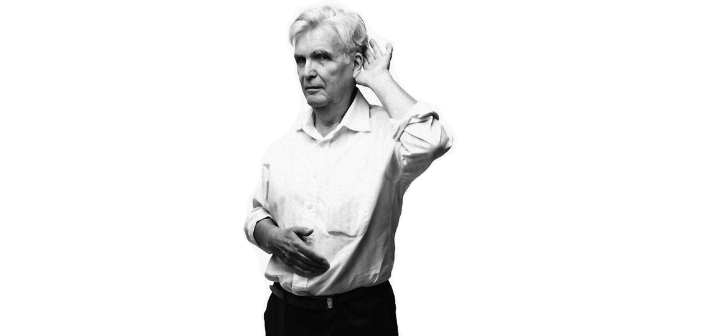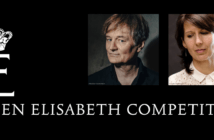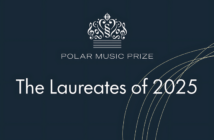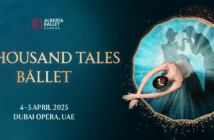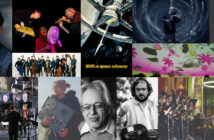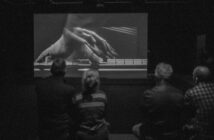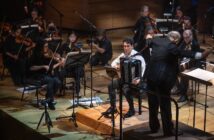
This page is also available in / Cette page est également disponible en:
![]() Francais (French)
Francais (French)
“One day, as I was playing a very simple tune, (…) my teacher wanted to make me feel the fluctuation of tempos, so he began playing the drums behind my back. To my surprise, I naturally followed the rhythm. I played and was being played. Just then, a group of musicians arrived (…) and played a constellation of contrapuntal rhythms. It was one of the most intense musical experiences of my life. I became almost weightless, lifted by so much beauty and also by the human communication that’s beyond speech. Being a musician among other musicians.” — Gilles Tremblay, travel report to the CAC, 1972.
I must say I was very touched when Raphaël Dubé invited me to help compose a piece for the funeral of his grandfather Gilles Tremblay. The idea was to honour the composer’s unique and far-reaching contribution to Quebec musicians. This artist dedicated his life to sensitizing not only his students to the world of sound but also the players who were lucky enough to meet him, and his audiences too. This man whose work itself is a rich and original school of musicality, and who experienced the joy of being a musician among other musicians, gave us a moment of sound poetry improvised using melodic fragments dedicated to his wife, the subject of reverent jubilation.
This article is about my delight in Tremblay’s music. I don’t want to let his great reputation and paternal aura eclipse his immense talent as a composer. I’ll show his vitality through three pieces that influenced me. This subjective selection includes many vocal compositions, because song is a very good way into the musical world of Gilles Tremblay.
In 1972 Tremblay returned from a study trip to the Far East that left a profound impression, both on his imaginative soundscape and on his calling as a composer. During the trip he composed Solstices (ou les jours et les saisons tournent) for flute, clarinet, horn, two percussions and double bass. He took part in a multiplex broadcast by Radio-France that showed him how such programs, communicating from one place to another, could have a musical character that triggered thoughts and reactions. This gave him the idea of writing a piece where instruments replaced speakers, creating their own conversation.
The place, date and time of the performance affect the way parts are organized. The piece comprises twelve sections (the months of the year) grouped into four zones (the seasons). The date of performance determines where the piece begins and colours the sound depending on the season. The form is circular. Each season is the responsibility of a soloist identified by an instrumental symbolism drawn from nature and matching the timbre, mode of broadcast and even the substance of the instrument.
This piece is central to the composer’s output. He pushed his concept of the music in impulses (Ranallo 2007) until the composer is no longer sole creator and the conductor is no longer sole conductor. The actual fabric of the music is renewed with each performance, because the players are co-responsible for its creation; they must apply their knowledge of the musical material and the rules of the work in order to play their roles properly. Véronique Lacroix had a group of students at the Conservatoire de musique de Montréal play the piece, and she considers it to be both formative and transformative.
The composer Walter Boudreau suggested an adaptation of the piece for his project Grand Jeu, extracting from the score teaching activities for different age groups so they could acquire the basic qualities of a musician: the ability to play together, to perceive the latent music around them, and to communicate via sound. Solstices is a musical-poetic movement irresistible to anyone who comes near it.
The creative period following Tremblay’s return from Asia was prolific. Jeux de Solstices (1973) is a double orchestral version of the first piece. Fleuves (1976), for full orchestra, is a crowning achievement. These works are all rooted in living phenomena: the cycle of the seasons, rivers and their tributaries, and, as we’ll see, the exploration of the sounds of matter.
Thus Oralléluiants, completed in 1974, is propelled by an imitation of the sounds made by a shaken sheet of aluminum, the imitation transfigured by the presence of a Gregorian Alleluia. The piece is for soprano, flute, bass clarinet, horn, three double basses, two or three percussions and amplification. Its title sandwiches the exclamation Alleluia between the two syllables of orant (meaning a person in prayer). This is a metaphor, reflecting the form of the music: a fluctuating zone of jubilant outbursts bridging two vast contemplative columns (Ranallo 2010). It’s a prayer in constellations, conveying an almost choreographic desire to embody exultation. The desire materializes when one of the percussionists dances with the cymbals around the others. St. Augustine would have regarded it as a manifestation of Ars bene movendi.

Like Solstice, this masterpiece appears as a school of music. Composer and players are “co-creators”, sharing responsibility for the material, its transformations and evolution. The decisions made during composition put down the markers setting the conditions for the surges and silences of the music. So the freedom of the long mobile continuum concluding Oralléluiants stems from a kind of supreme hearing apprenticeship guided by the work. The same finality reappears at the end of Magnificat des Vêpres de la Vierge (1986) with its sublime soprano solo.
Aware of the excitement about the year 2000, Tremblay asks the existential question about time that was raised by Olivier Messiaen from a philosophical aspect. Tremblay wanted to examine the human drama in its concrete relationship to others and the world. His anguished response is the imposing monologue À quelle heure commence le temps (1999) for baritone, piano and 15 instrumentalists.
The question in the title, stemming from discussions with composer Hubert Reeves, inspired the poet Bernard Lévy to write a three-voice song (performed by the baritone according to the techniques inspired by Asian theatre): a lone sailor, the sea which he loves, and the wind he must confront and which overpowers him in the end. This downfall ended the original text. Tremblay felt it to be a sort of allegory of the Holocaust and of Hitler, personified by the wind’s homicidal madness. But he couldn’t bear the story to end in horror, and persuaded Lévy to rewrite it: the sailor notices what had always been there: the Light, which receives him in the end. After a gigantic surge, the monodrama concludes with a leap into the unknown conveyed by the sympathetic resonance of the piano propelled by the trumpeting of the horn.
Apart from the expressive power of the work, the listener is struck by a monumental resonance, a chord borrowed from Fleuves and possessing a special impact. This harmony is based on a deep sustained note consisting of an augmented fourth above which the other elements pile up dizzily over nearly seven octaves respecting and overstepping the harmonic sounds that strengthen or disturb each other. At the centre of all this, supported by the declamations of the baritone, a flat major chord shines forth like the sea in sunshine.
These dazzling effects are Gilles Tremblay’s musical signature. His language is complex but not complicated, and its diversity comes from several planes under the creative responsibility of the musicians. There’s no rigidity under an authoritarian baton, rather a convivial to-and-fro preparing for an adoring silence.
Bibliographie sélective et liens
- I highly recommend the Canadian Music Centre: www.musiccentre.ca. It offers many recordings of Tremblay’s works.
- Several videos of his music are available here: https://www.youtube.com/playlist?list=PL77IbI6weohkf0JerPwWyxLwSEEusu0g3
- Ranallo, Vincent (2007) « L’écoute créative dans les mobiles de Gilles Tremblay », La Scena Musicale, vol.12 no 7, April 2007.
- Ranallo, Vincent (2010) « Une célébration sonore de l’Esprit. À propos d’Oralléluiants de Gilles Tremblay », Circuit, musiques contemporaines, vol. 20 no 3, p. 45-60.
- Ranallo, Vincent (2011) « Considérations sur l’art vocal dans l’œuvre de Gilles Tremblay », Cahiers de la SQRM, vol.12 no 1-2, p. 73-82.
- Richard, Robert, Éblouissement, Gilles Tremblay et la musique contemporaine, Montréal, Éditions Nota bene, 2013.
This page is also available in / Cette page est également disponible en:
![]() Francais (French)
Francais (French)

